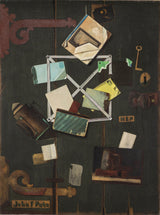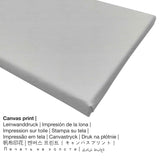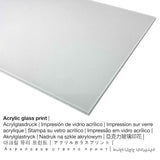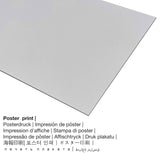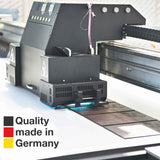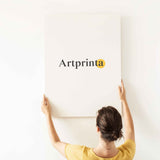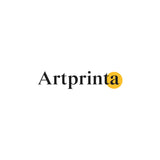John Frederick Peto, 1900 - Foto HSP's Rack - ọmarịcha nka
Ụtụ gụnyere. Mbupu gbakọrọ na ndenye ọpụpụ.
Akụrụngwa ndị ahịa anyị nwere ike ịhọrọ
N'ime menu ndọpụta ngwaahịa ị nwere ike họrọ ngwa na nha dabere na mmasị gị. Ị nwere ike ịhọrọ n'ime nhọrọ nhazi ngwaahịa ndị a:
- Mbipụta iko acrylic (nke nwere ezigbo mkpuchi iko n'elu): The acrylic glass print, often referenced as a an art print on plexiglass, will convert your selected original into brilliant décor. The artwork is made with the help of state-of-the-art UV printing machines. This creates impressive and vivid color hues. With an acrylic glass fine art print contrasts plus small artwork details will be more exposed with the help of the delicate gradation.
- Mbipụta nke aluminom: Aluminium Dibond prints are metal prints with an impressive effect of depth, which creates a fashionable impression throuch a non-reflective surface structure. The direct print on Aluminum Dibond is one of the most demanded entry-level products and is a sophisticated way to display art prints, since it puts the viewer’s attention on the artwork.
- Kwaaji: A printed canvas material mounted on a wood stretcher frame. Canvas Prints have the advantage of being relatively low in weight, which means that it is quite simple to hang up your Canvas print without the support of extra wall-mounts. Hence, canvas prints are suited for all types of walls.
- Akwụkwọ mmado na ihe kwaaji: Our poster print is a printed canvas with a slightly roughened texture on the surface, which reminds the actual version of the masterpiece. Please keep in mind, that depending on the size of the canvas poster print we add a white margin 2-6cm around the painting in order to facilitate the framing.
Nkwupụta iwu: We try the best we can to describe the art products as precisely as possible and to illustrate them visually on the respective product detail pages. Please keep in mind that the colors of the print products, as well as the imprint can vary slightly from the image on the screen. Depending on your settings of your screen and the nature of the surface, not all colors are printed one hundret percent realistically. Bearing in mind that our art reproductions are printed and processed manually, there may also be slight variations in the exact position and the size of the motif.
What does the original artwork description of the Los Angeles County Museum of Art say about the 20th century artwork made by John Frederick Peto? (© - site na Los Angeles County Museum of Art - Ebe ngosi nka nke Los Angeles County)
John Frederick Peto (1854-1907) was born and raised in Philadelphia. He espoused a highly realistic style of painting that reflected the period's rationalism and concern for materiality, an aesthetic in opposition to the freer and individualistic handling of paint of the contemporaneous impressionists. In the late 1870s, Peto entered the Pennsylvania Academy of the Fine Arts, where he became friends with William Harnett, recently returned to the academy after several years in New York City. It was about this time that Harnett began exhibiting his mature illusionistic still lifes. Although most still life painters aim to be convincingly realistic, Harnett went beyond mere imitation, often to the point of deception. These still lifes made Harnett’s fame and spawned a virtual movement of followers. Peto considered Harnett his "ideal of perfection in still life painting," and as Harnett, specialized in still lifes, both table-top compositions and trompe l’oeil ("deceives the eye"). Yet Peto was no mere imitator. Unlike many of his contemporaries, Peto did not consider the visual trickery and illusion so often associated with works of trompe l’oeil as the sole aim of his art. In Harnett’s paintings, objects were depicted so realistically that many people actually had to touch the canvas before they were convinced that the objects they were seeing were painted, not "real." Peto, however, was more concerned with the manner in which light could affect an object rather than with the precise rendering of that object, and his canvases have a softer, less hard-edged style. Read more (Curator Notes)
Ihe osise nke oge a bụ nke kere nwoke American painter John Frederick Peto in 1900. Ọzọkwa, a na-etinye ihe osise a n'ime Ụlọ ihe ngosi nka nke Los Angeles County nchịkọta ihe nka dijitalụ, nke bụ ụlọ ngosi nka nka kachasị na ọdịda anyanwụ United States, yana nchịkọta ihe karịrị 142.000 na-enwu enwu afọ 6.000 nke ngosipụta nka n'ofe ụwa. Nke a ngalaba ọha artpiece is included with courtesy of Los Angeles County Museum of Art (www.lacma.org).In addition to that, the work of art has the creditline: . In addition to that, the alignment of the digital reproduction is in Eserese usoro na a akụkụ ruru nke 3: 4, nke pụtara na ogologo bụ 25% mkpụmkpụ karịa obosara. The painter John Frederick Peto was an artist from United States, whose artistic style can mainly be classified as Realism. The painter was born in 1854 in Philadelphia, Philadelphia county, Pennsylvania, United States and died at the age of 53 na 1907 na New York City, New York steeti, United States.
Tebụl nka nka
| Aha nka nka: | "HSP's Rack Picture" |
| Nhazi nka nka: | sere |
| Okwu mkpokọta: | nkà nke oge a |
| oge: | 20th narị afọ |
| Afọ nka: | 1900 |
| Afọ nka: | 120 afọ |
| Ihe osise izizi: | mmanụ na kwaaji |
| Ụlọ ihe ngosi nka: | Ebe ngosi nka nke Los Angeles County |
| Ebe ngosi nka: | Los Angeles, California, Njikota Obodo Amerika |
| Weebụsaịtị nke ihe ngosi nka: | www.lacma.org |
| Ụdị nka nka: | ngalaba ọha |
| Site n'aka: | Ụlọ ihe ngosi nka nke Los Angeles County (www.lacma.org) |
Nkọwa ngwaahịa
| Ụdị ngwaahịa: | nka nka |
| Usoro mmeputakwa: | dijitalụ mmeputakwa |
| Production usoro: | mbipụta dijitalụ |
| Mmalite ngwaahịa: | arụpụtara na Germany |
| Stockdị ngwaahịa: | mmepụta ihe na-achọ |
| Eji ngwaahịa a chọrọ: | ihe osise nka, nka mgbidi |
| Ndepụta: | nhazi ihe osise |
| Njikwa oyiyi: | ( Ogologo: obosara) 3: 4 |
| Ntụgharị nkọwa akụkụ akụkụ: | ogologo bụ 25% mkpụmkpụ karịa obosara |
| Ụdị dị iche iche dị: | Mpempe akwụkwọ mmado (akwụkwọ kwaaji), mbipụta kanvas, mbipụta ọla (aluminium dibond), mbipụta iko acrylic (nwere ezigbo mkpuchi iko) |
| Mbipụta kanvas (akwa akwa na etiti ihe ndọtị) dị iche iche: | 30x40cm - 12x16", 60x80cm - 24x31", 90x120cm - 35x47" |
| Mbipụta iko acrylic (nke nwere ezigbo mkpuchi iko): | 30x40cm - 12x16", 60x80cm - 24x31", 90x120cm - 35x47" |
| Mbipụta akwụkwọ mmado (akwụkwọ kwaaji): | 30x40cm - 12x16", 60x80cm - 24x31", 90x120cm - 35x47" |
| Nhọrọ nha mbipụta aluminium dibond: | 30x40cm - 12x16", 60x80cm - 24x31", 90x120cm - 35x47" |
| Igwe onyonyo: | enweghị etiti |
Nchịkọta ihe nkiri
| aha: | John Frederick Peto |
| Aha ndị ọzọ: | jon f. peto, Peto John F., John Frederick Peto, Peto John Frederick, Peto |
| okike nke onye nka: | nwoke |
| Obodo onye nka: | American |
| Ọrụ onye na-ese ihe: | onye na-ese ihe |
| Obodo obibi: | United States |
| nhazi ọkwa: | omenkà nke oge a |
| Ụdị nka: | Ihe ngosi |
| Akwụsị: | 53 afọ |
| Afọ amụrụ: | 1854 |
| Ebe amụrụ onye: | Philadelphia, Philadelphia County, Pennsylvania, Njikota Obodo Amerika |
| Afọ nwụrụ: | 1907 |
| Nwụrụ na (ebe): | New York City, New York State, Njikota Obodo Amerika |
© Nwebiisinka nke, Artprinta (www.artprinta.com)

